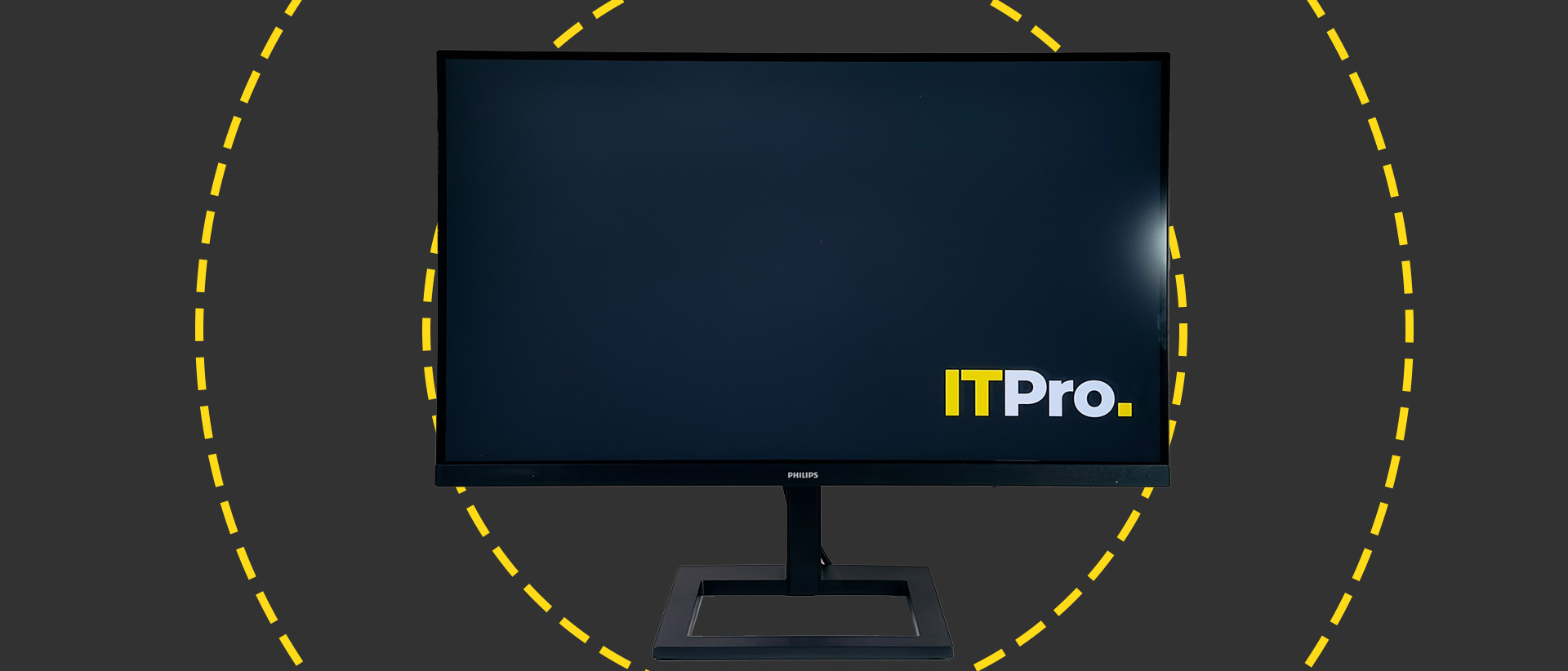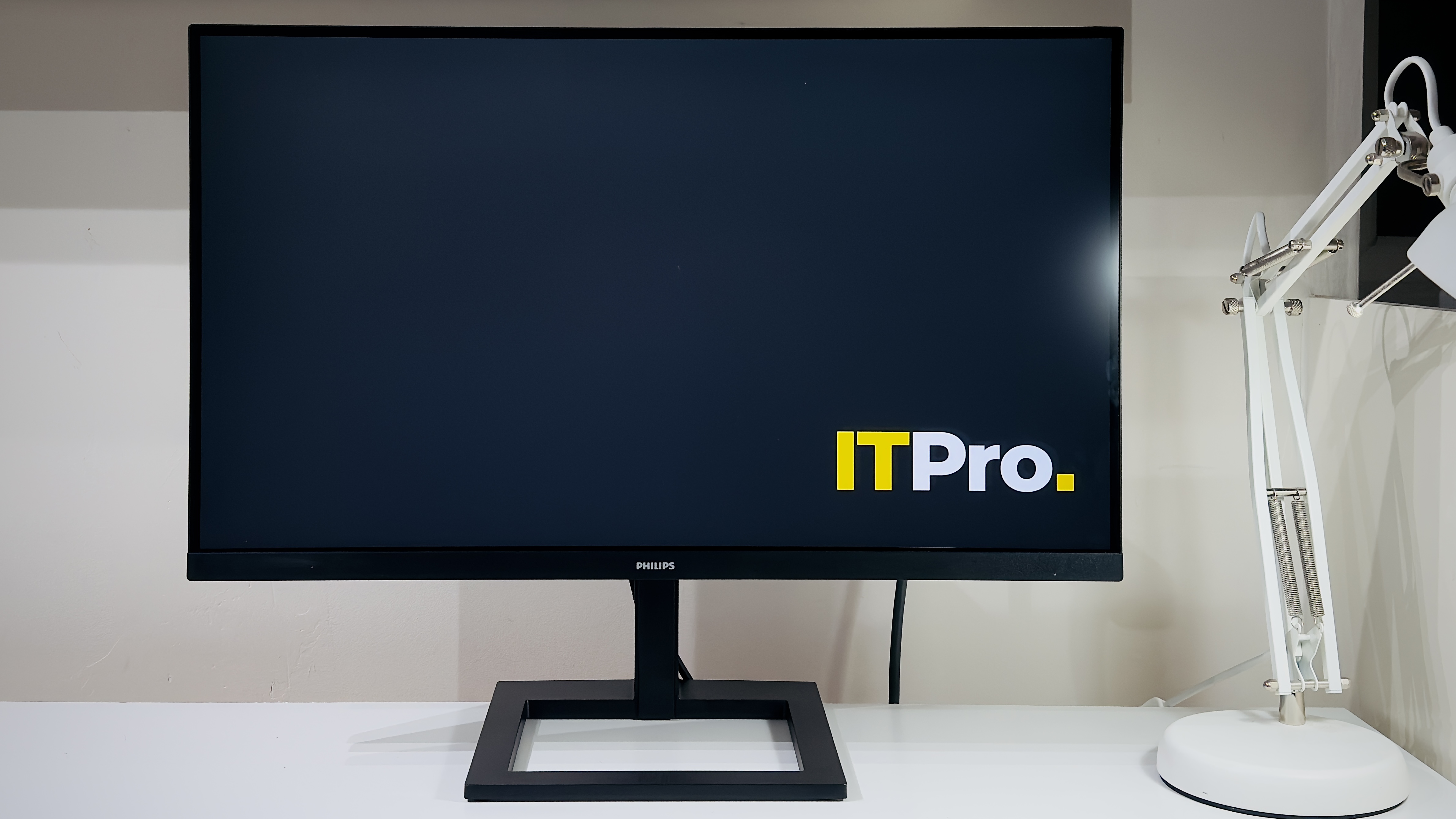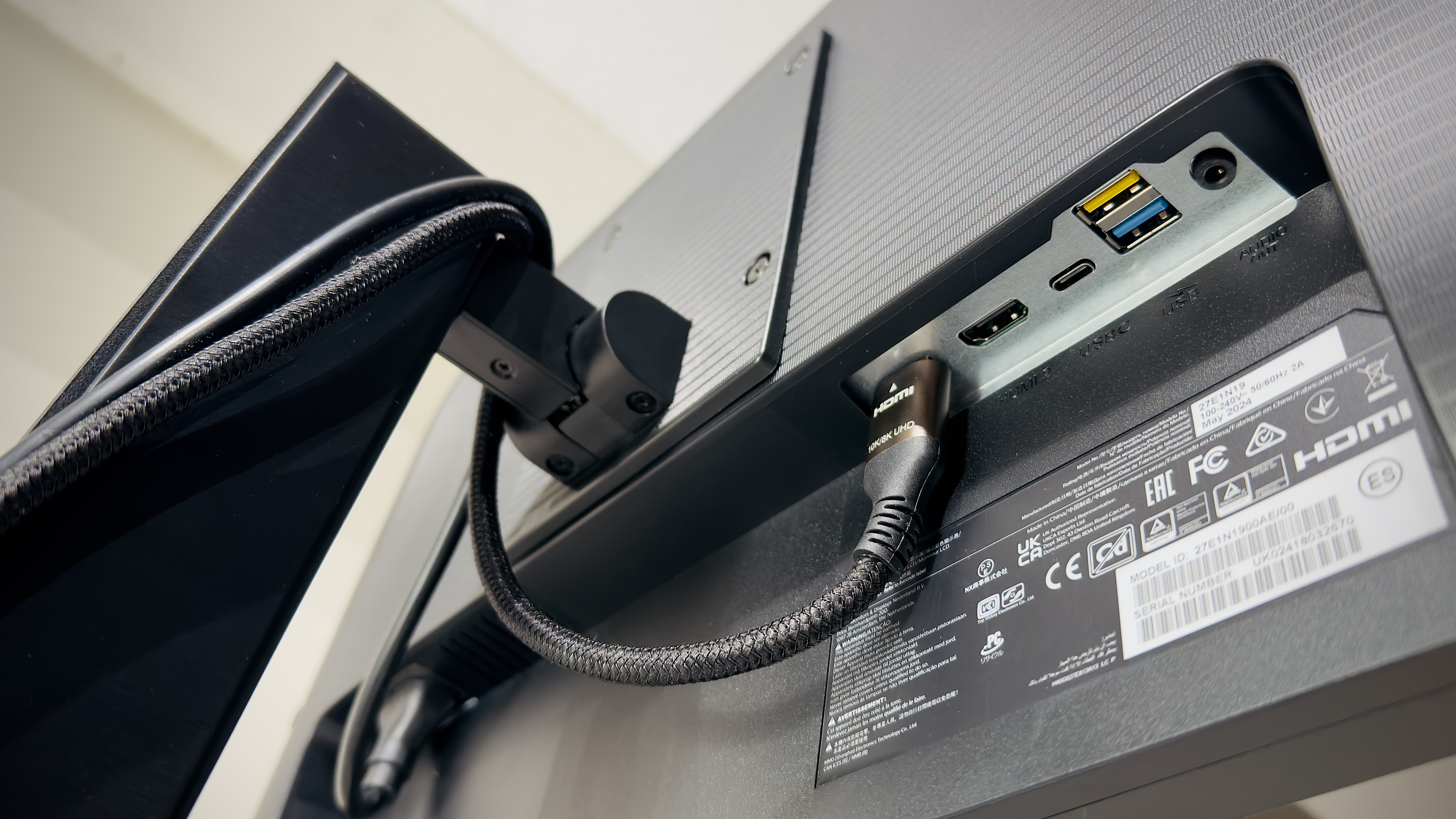Philips 27E1N1900AE monitor review: Cheap 4K comes with a catch
A quietly impressive budget monitor with more features than you'd expect – but you'll have to put up with terrible IPS glow

-
+
Good sRGB and P3 color accuracy
-
+
65W USB-C PD and two-port hub
-
+
Height adjustable stand
-
-
Terrible viewing angles
-
-
Fiddly OSD controls
-
-
Only two USB-A ports

If you're wondering why we're reviewing the same Philips monitor for a second time, then you'll need to reread the product name. This isn't the excellent Philips 27E1N1600AE (£199) which we recommended back in July 2024. This is the slightly pricier Philips 27E1N1900AE. This model doesn't just turn the 6 upside down and add £50 to the price, however – it also bumps up the resolution to 4K.
Barring some very slight design differences, the main upgrade here is the move from a WQHD 2,560 x 1,440 panel to a 4K 3,840 x 2,160 one. With all those pixels packed into a 27in IPS panel, you can look forward to crystalline images and text clarity – the only downside being that most of us will need to employ OS scaling to bump up the standard font size. Everyone, that is, except those blessed with truly exceptional eyesight.
In addition to its high pixel density, the Philips 27E1N1900AE touts the kind of feature list which marks it out as being well-suited to office duties. The USB-C connectivity is a great fit for modern laptops, with a single cable sending DisplayPort signals in one direction and 65W of battery-replenishing power delivery in the other. You also get a height-adjustable stand, a two-port USB-A 3.2 Gen 1 hub, and a matte anti-glare coating which is ideal for most common office lighting conditions.
If you think this all sounds pretty comprehensive for the money, then we'd be inclined to agree. And after reading this review, you may even end up being as impressed as we were by some aspects of its performance. The crushing news, then, is that the 4K panel lets the side down in a way that's very, very difficult to ignore.
Philips 27E1N1900AE monitor: Design & Features
If you're hoping for a stylish business monitor at a cut-down price, then the 27E1N1900AE isn't quite as dapper as its cheaper stablemate, the 27E1N1600AE. In fact, it's a great example of how minor design changes can radically alter a product's look. Placed alongside its stablemate, the 27E1N1900AE's slightly thicker, more plasticky chin, replete with a larger Philips logo, makes the monitor look immediately more clunky and low-end. It's a very minor change, but the tiny logo and narrow chin on the cheaper model look far more elegant by comparison.
In other regards, the fact that the 27E1N1900AE is almost identical to its cheaper stablemate is the very definition of a good thing. You get the same squared-off stand with a useful cutout in the middle for stashing pens, paperclips, or office lanyards; the same simple clips at the back for basic cable management duties and the same 100mm of height adjustability alongside a basic amount of front to back tilt. The basic workplace essentials all get a confident tick in the box.
Again, alongside the USB-C and HDMI ports, you also get a two-port USB-A 3.2 Gen 1 hub. The only issue here for single-cable USB-C converts is that you'll need to pick between sending 4K 60Hz signals and limiting yourself to USB 2.0 transfer speeds, or halving the refresh rate to 30Hz in exchange for full-speed USB 3.2 Gen 1 transfers. Thankfully, the HDMI input provides an alternative way of sending a full-fat 4K 60Hz signal without slowing the integrated USB hub down to a crawl – some users may prefer to put up with two cables to take advantage of higher transfer speeds.
Sign up today and you will receive a free copy of our Future Focus 2025 report - the leading guidance on AI, cybersecurity and other IT challenges as per 700+ senior executives
The feature list is perhaps a tad frugal when judged against some of the recent monitors we've tested, but then this is a £249 monitor. With that firmly in mind, it's fairly easy to forgive the cheaper-looking elements of the design, the two-port USB hub, or the lack of any pivot or side to side swivel functions for the stand. This is clearly an exercise in packing as many pixels and business-focused features as possible into a fairly tight budget. Which makes it all the more impressive to find that Philips also supplies a decent handful of cables in the box, with the usual power cable accompanied by a 1.5m HDMI cable and a sensible 1.8m length of USB-C to USB-C cable.
The cost-cutting does make itself obvious in a number of places, though. For instance, the on-screen display is the same as that on the 27E1N1600AE, but the user interface is now comically tiny. Rather than scale the user interface up to match the display's higher pixel density, Philips has just left it alone: the result is tiny text and menus that may not be easily legible for older eyes. The single joystick-style power button at the rear remains a tad fiddly in use – it's set a little too far around the back of the panel, so even big hands will find it awkward to get at.
Philips 27E1N1900AE monitor: Display quality

We'd normally save the bad news for the end of this section, but the Philips 27E1N1900AE's one major image quality flaw is going to be a dealbreaker for most users. In short, the viewing angles are simply dreadful. If we'd bought this on the specification list alone, we'd probably have returned it shortly after putting it through its paces.
First, a bit of an explainer. While IPS panels are usually fairly well regarded for having wide viewing angles, they're also well known for exhibiting a visual artifact known as IPS glow, which is where parts of the screen appear to glow with an off-white haze. This usually worsens as you move your head away from a perfect head-on position directly in front of the monitor, but the effect is usually either subtle or virtually invisible as long as you stay reasonably centered. Usually, the better the quality of the IPS panel, the less intrusive the glow. Unfortunately, the Philips' 27E1N1900AE's panel exhibits such terrible IPS glow that you can see the corners of the screen shimmer and change hue with even the slightest head movements.
The color shifts are less noticeable if you move further away, but we're generally sat around an arm's length from our monitor – as are most office users – and sitting over a meter away doesn't make much sense for a pixel-dense 4K 27in monitor. At a normal viewing distance, it's fair to say that the changes in color can be hugely distracting – color tones darken as you move away from head-on, and it looks as though the monitor is shimmering even when you're just reading up and down a simple text document. The issue is less noticeable while watching YouTube videos or playing games with lots of onscreen movement, but the moment things slow down it's hard not to notice.

It's a crying shame because the monitor performs quite well in other areas. It might sound counterintuitive to state that color accuracy is actually quite good, but as it's measured from a single point on the screen with our X-Rite colorimeter, it objectively is. The panel itself covers 99.9% of the sRGB gamut, and even though Philips doesn't shout about it in its marketing, it also covers 96% of the P3 gamut, which is a bonus.
In fact, it tests very well against the Display P3 color space, achieving an average Delta E of 1.66 and a maximum deviation of 3.65. Switch to the monitor's sRGB mode (which you'll find in the Color section of the on-screen display) and you get even better results, with an average Delta E of 0.93 and a maximum of 2.5. Those are some very respectable results for a £250 monitor, and as good as we've seen from some monitors at more than twice the price.
Other aspects of the Philips's picture performance are more middle-of-the-road, but they're acceptable. Brightness peaks at 290cd/m2 measured at the center of the screen, which is roughly double the figure you'll comfortably need for everyday office use, and the measured contrast ratio of 1,100:1 is what we'd expect for a budget-oriented IPS panel.
More crucial for business is the choice of anti-glare coating, and here Philips has opted for a matte layer with a fairly light 25% haze, which does a pretty good job of diffusing unwanted reflections. The reflectivity is a little higher than some matte anti-glare panels – the Asus PA278CFRV, for instance – but it's far more effective than the semi-gloss finish on Dell's UltraSharp U2723QE. For office use, the Philips strikes a sensible balance between the two camps.
It's worth knowing that the Philips does also support HDR, but despite the broad palette of colors at its disposal, the 4K panel neither goes bright enough nor has sufficient contrast to make a good job of HDR content – we'd recommend sticking with SDR content wherever possible. The presence of adaptive sync in the guise of AMD Freesync support is slightly more welcome, but even this is of limited benefit for a 60Hz display.
Philips 27E1N1900AE monitor: Is it worth it?
While it's not unusual to see 27in 4K monitors start to appear around the £200 to £250 mark, you normally need to make do with limited connectivity and basic stands with limited adjustability. Luxuries such as height-adjustable stands, USB hubs, and USB-C connectivity are anything but a given. It's actually quietly impressive, then, to see how many features Philips has crammed into the 27E1N1900AE for the money.
Despite all that, though, we simply can't recommend the 27E1N1900AE – the viewing angle issues are too intrusive for office work. For a good, all-round office monitor, we'd definitely opt for the 27E1N1600AE instead, as what you lose in resolution, you gain in better all round picture performance. Sometimes, less really is more.
Philips 27E1N1900AE specifications
| Display | 27in IPS panel | Row 0 - Cell 2 |
| Panel resolution | 3,840 x 2,160 | Row 1 - Cell 2 |
| Refresh rate | 60Hz | Row 2 - Cell 2 |
| Panel response time | 4ms GTG | Row 3 - Cell 2 |
| Adaptive Sync Support | Yes, AMD Freesync | Row 4 - Cell 2 |
| HDR Support | Yes | Row 5 - Cell 2 |
| Ports | HDMI 1.4 x 1, USB-C 3.2 Gen 1 x 1, USB-A 3.2 Gen 1 x 2, 3.5mm audio out | Row 6 - Cell 2 |
| Other features | UB PD 3.0 (up to 65W) | Row 7 - Cell 2 |
| Stand | Ergonomics -5~20° tilt, 100mm height adjustment | Row 8 - Cell 2 |
| Dimensions (with stand) | 613 x 492 x 220mm | Row 9 - Cell 2 |
| Weight (with stand) | 5.97kg | Row 10 - Cell 2 |
Sasha is a freelance journalist who's been writing about tech and consumer products for over two decades. With a career that started at the dawn of the millennium on Computer Buyer magazine, he passed through the official Intel Centrino magazine, Mobile Computer, before rounding off his print career on PC Pro magazine where he reviewed a broad spectrum of hardware and software before eventually specializing in laptop and monitor reviews. After the best part of a decade, he defected to the desks on the other side of the office and spent many years working on Expert Reviews before finally going freelance in 2024. Nowadays, he splits his time between reviewing tech and home appliances, falling off mountain bikes and cleaning up his kids' playroom.
-
 OpenAI's 'Skills in Codex' service aims to supercharge agent efficiency for developers
OpenAI's 'Skills in Codex' service aims to supercharge agent efficiency for developersNews The Skills in Codex service will provide users with a package of handy instructions and scripts to tweak and fine-tune agents for specific tasks.
By Ross Kelly Published
-
 Cloud infrastructure spending hit $102.6 billion in Q3 2025 – and AWS marked its strongest performance in three years
Cloud infrastructure spending hit $102.6 billion in Q3 2025 – and AWS marked its strongest performance in three yearsNews Hyperscalers are increasingly offering platform-level capabilities that support multi-model deployment and the reliable operation of AI agents
By Emma Woollacott Published
-
 Google Cloud teases revamped partner program ahead of 2026
Google Cloud teases revamped partner program ahead of 2026News The cloud giant’s new-look partner ecosystem shifts focus from activity tracking to measurable customer outcomes
By Daniel Todd Published
